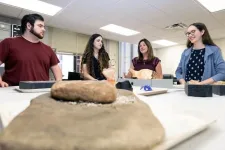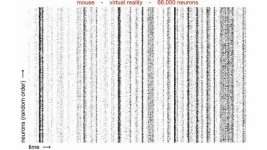(Press-News.org) Male birds help their parents less than females because they’re too busy scouting for new places to live and breed, a remarkable new study shows.
The study, led by researchers at the Centre for Ecology and Conservation at the University of Exeter, examined the cooperative behaviour and movement patterns of social birds called white-browed sparrow weavers, which live in the Kalahari desert.
These birds live in family groups in which only a dominant pair breeds – and their grown-up offspring, particularly females, help to feed nestlings.
The new study aimed to understand why in many animal societies one sex tends to invest more in helping within the family than the other.
“Female sparrow-weaver helpers contribute more to cooperative nestling care than males and also stay for longer in their family groups than males,” said Dr Pablo Capilla-Lasheras, who led the study during his PhD at Exeter and now works at the Swiss Ornithological Institute.
“We wanted to understand why such sex differences in cooperation arise across the animal kingdom.
“The leading hypothesis is that the sex that lives for longer in its family group cooperates more because it stands to gain the downstream benefits of cooperation for longer.
“For example, the sex that stays in their family group for longer could receive more help in return from those family members they’ve helped in the past than the sex that leaves earlier.”
Through over a decade of field research monitoring the cooperative behaviour of these birds and a ground-breaking tracking study of their movements, the team’s work suggests that this is not the case after all.
“Our findings point instead to an alternative explanation that has attracted much less attention,” said Dr Andrew Young, who leads the Kalahari sparrow-weaver project.
“Instead, males appear to help less because they spend more time prospecting for opportunities to live and breed elsewhere, and these efforts trade-off against their investments in cooperation at home.”
Based on their findings, the team suggest that this ‘dispersal trade-off hypothesis’ may provide a more general explanation for the evolution of sex differences in cooperation across animal societies than the more widely held view that “the longer you stay, the more you’ll benefit from having helped out”.
This trade-off is an example of a universal challenge that all organisms face, including ourselves; there is never enough time or energy available to do everything well at once.
The study was funded by the Natural Environment Research Council and the Biotechnology and Biological Sciences Research Council.
The paper, published in the journal PLOS Biology, is entitled: “Evolution of sex differences in cooperation can be explained by trade-offs with dispersal.”
END
Bird study finds sons help their parents less than daughters because they’re scouting future prospects
2024-10-24
ELSE PRESS RELEASES FROM THIS DATE:
Wake Forest Institute for Regenerative Medicine (WFIRM) awarded up to $48 million to utilize body-on-a-chip technologies to study fibrosis-inducing chemical injuries
2024-10-24
The Wake Forest Institute for Regenerative Medicine (WFIRM) has been awarded an eight-year contract, valued up to $48 million from the U.S. Department of Health and Human Services (HHS) to support the utilization of cutting-edge body-on-a-chip technologies aimed at studying and developing potential treatments for sulfur mustard and other fibrosis-inducing chemicals. The program has been approved with an initial contracting commitment of approximately $18 million.
This contract represents a continued partnership between WFIRM and the Biomedical Advanced Research and Development Authority (BARDA), ...
Study offers ‘compelling evidence’ for continuous stroke care improvement
2024-10-24
Research Highlights:
A retrospective look at Get With The Guidelines® – Stroke registry data from 2003 to 2022 finds substantial and sustained improvements in acute stroke care among those in the quality improvement program.
Researchers found increased adherence to evidence-based stroke care translates to better clinical outcomes and, ultimately, more patients being discharged home or to a skilled nursing facility more quickly.
Overall, authors say the positive trends suggest concerted quality improvement initiatives can improve ...
Professor awarded NEH grant to advance anthropology research collections at Texas A&M
2024-10-24
Dr. Katie Custer Bojakowski, an instructional assistant professor in the Department of Anthropology at Texas A&M University and the director and curator of its Anthropology Research Collections (ARC), has been awarded a Preservation Assistance Grant from the National Endowment for the Humanities (NEH).
The NEH’s Preservation Assistance Grants program helps organizations protect their collections of historical and cultural items, making sure they remain available for students, scholars and the public. These grants help address risks to these collections, ...
New tool helps scientists spot patterns in mountains of data
2024-10-24
Neuroscientists have learned a lot – like which neurons and circuits are associated with different behaviors – by recording the activity of small sets of neurons.
But what happens when you record thousands of neurons at one time? Or when you want to figure out the role of neurons when there isn’t an obvious external catalyst or you’re not sure what you’re even looking for?
That’s where Rastermap comes in.
The new visualization tool developed by the Stringer and Pachitariu labs at HHMI's Janelia Research Campus helps ...
Glomerular filtration rate changes following UTI in children with vesicoureteral reflux
2024-10-24
About The Study: This cohort study uses data from the Children With Vesicoureteral Reflux trial to assess estimated glomerular filtration rate (eGFR) changes in participants with vs without recurrent urinary tract infections.
Corresponding Author: To contact the corresponding author, David S. Hains, MD, MBA, email dhains@iu.edu.
To access the embargoed study: Visit our For The Media website at this link https://media.jamanetwork.com/
(doi:10.1001/jamapediatrics.2024.4546)
Editor’s Note: Please see the article for additional information, including other authors, author contributions ...
Dandelion-shaped supernova and zombie star
2024-10-24
In 1181, a new star shone near the Cassiopeia constellation for six months before disappearing. This event, recorded as a “guest star” by Chinese and Japanese observers almost a millennium ago, has puzzled astronomers for centuries. It is one of a few supernovae to be documented before the invention of telescopes. In addition, it remained an “orphan” the longest, meaning that none of the celestial objects visible today could be assigned to it. Now known as the supernova SN 1181, its remnant has only been traced in 2021 to the nebula ...
Experts call for clear and concise regulation of exosome-based treatments
2024-10-24
Clinics that offer exosome therapies claim they have the ability to repair and regenerate tissues and treat inflammatory and other immune-related conditions in a noninvasive way. Now, a team of bioethicists and legal scholars from Japan is sounding the alarm on the urgent need for stronger regulations surrounding these unproven interventions. Their letter appears October 24 in the journal Stem Cell Reports.
“Administering these treatments to patients without scientific evidence or a clear ...
Zebrahub: New atlas tracks zebrafish development like never before
2024-10-24
When early cartographers undertook perilous expeditions to map unknown corners of the world with sextants, compasses, and hand-drawn diagrams, it’s unlikely they imagined that someday anyone with an internet connection would have access to a seamless view of the entire planet from the comfort of their own home. Today, pioneering scientists are working to create a similar experience for a much tinier, but no less important domain: developing embryos. The goal is to track and map the behavior of each and every cell working together to create an adult lifeform, and present that map in a clickable, ...
Unnoticeable electric currents could reduce skin infections
2024-10-24
Using a few zaps of electricity to the skin, researchers can stop bacterial infections without using any drugs. For the first time, researchers designed a skin patch that uses imperceptible electric currents to control microbes. The results appear October 24 in the Cell Press journal Device.
“This opens up exciting possibilities for drug-free treatments, especially for skin infections and wound healing, where antibiotic-resistant bacteria pose a serious challenge,” says University of Chicago’s Bozhi Tian, one of the paper’s ...
Expanded newborn screening using genome sequencing for early actionable conditions
2024-10-24
About The Study: These interim findings demonstrate the feasibility of targeted interpretation of a predefined set of genes from genome sequencing in a population of different racial and ethnic groups. DNA sequencing offers an additional method to improve screening for conditions already included in newborn screening and to add those that cannot be readily screened because there is no biomarker currently detectable in dried blood spots. Additional studies are required to understand if these findings are generalizable to populations of different racial and ethnic groups and ...





